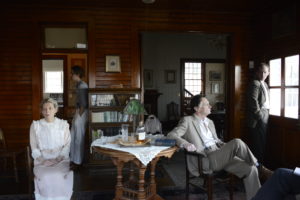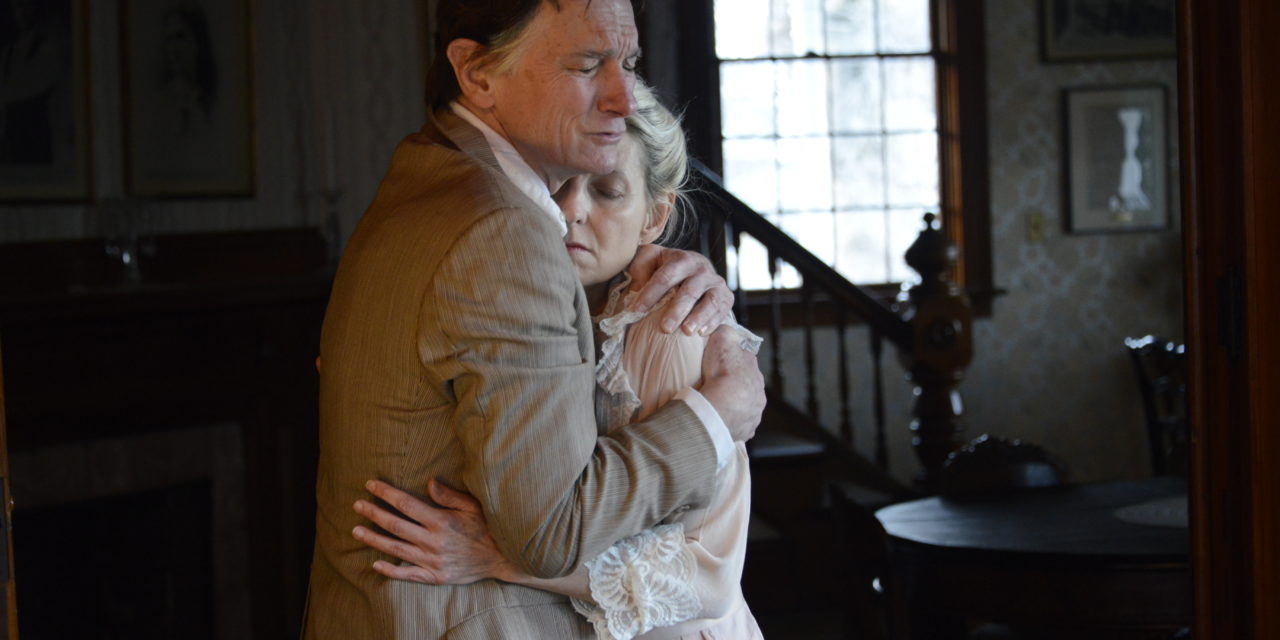On the first night of rehearsal in the Monte Cristo Cottage in New London, CT, Flock Theatre Artistic Director Derron Wood poked me and with a boyish grin whispered, “Hear that?” While Victor Chiburis banged through his Act IV monologue about being lost in the sea and fog, downriver, the New London foghorn moaned in the dark. The coincidence of actual fog arising in concert with its textual reference represented the aesthetic—part naturalism, part realism—that Derron sought in his production of Long Day’s Journey Into Night, the first to be performed in full in Eugene O’Neill’s boyhood home.
Since the early 1990s, when Derron moved his company to New London, he had dreamed of staging O’Neill’s autobiographical masterpiece in the cottage. A graduate of Connecticut College, Derron is no stranger to the town’s place in the history of American theatre, nor to the cottage itself; he had been housed there when he spent a semester at the National Theater Institute. He itched to put audience and action together in the fourteen by fourteen-foot, wood-paneled parlor. There stand the bookcases O’Neill described, the chandelier with “one bulb burning,” the round table and four chairs, and the ribbons of windows facing east, south, and west, through which, over the course of a day, sunlight streams in, changing direction and brightness, until night overtakes it and the room goes dark.
In the spring of 2017, Derron got his chance. In collaboration with the Eugene O’Neill Theater Center, which owns the cottage, he mounted the play with a cast of local actors: Christie Williams as James Tyrone, Victor Chiburis as Edmund, Eric Michaelian as Jamie, and Amy Bentley as Cathleen. I played Mary Tyrone, Kristen Rowe was stage manager, and Laura Galgowski designed the costumes.
We all understood that the house would become a character, and Derron knew if he highlighted the negative space of the text by exploiting the elements of space, place, and time in a natural way, he could create a unique production, difficult to replicate anywhere else. To do this, he used the house as is, its configuration, lighting, acoustics, and furniture composing a complete set. Then he asked us to work in a naturalistic vein, using our conversational voices and minimizing the size of our gestures and facial expressions.
We had little room to move, in any case. In Derron’s staging, the audience shared the acting space with us. They sat in the wood-paneled parlor, facing the interior of the house. Although we used all the house’s rooms—upstairs and down, including the porch, surrounding the audience in a sphere of action—most of the play unfolded in the parlor, only inches away from them. Unless an individual was willing to disrupt a scene that was underway, he or she was trapped in the parlor with us until an act ended. No one could escape, and at times the claustrophobia was palpable.

From left to right: Anne Flammang, Victor Chiburis, Christie Williams, and Eric Michaelian. Photo by A. Vincent Scarano, 2017.
During intermission, Derron offered tours of the house, so the audience could see the low ceilings of the second floor, the proximity of the bedrooms to each other, the clarity with which sound travels through walls and up the stairs—indications of the house’s limited personal and private space. We left our costume pieces in our characters’ rooms, which hinted at a life beyond the script. In this environment, those on the tour could see there was no alteration to the setting of the play, only the Tyrone home. In fact, to get to their seats, the audience had to walk through spaces where the Tyrones spend their day—up the same porch stairs, through the same front door, and across the same floors. The fourth wall in this production was no more than a breath of air.
Derron extended the space of the house to the place of the story—New London—and he provided maps so the audience could later visit sites associated with Eugene O’Neill’s family—the building where they garaged the Packard; the Thames Club, where a tile with James O’Neill’s silhouette hangs in a downstairs pub; and St. Mary’s Cemetery, where everyone in the family except Eugene, is buried. No one could have left a performance confused about who the Tyrone’s really were or what sorrows the O’Neill family had suffered within the four walls of that house.
Besides space and place, Derron also played with time by staging the play with long breaks between the acts. He offered audiences a choice of two performance formats, a short day and a long day. On short days, the first half of the play (Acts I and II) began at 3:00 PM, and the second half (Acts III and IV) at 7:30 PM. On the long days, Act I began at 9:00 AM, Act II at 12:45 PM, Act III at 6:30 PM, and Act IV at 7:45 PM. The breaks were long, so the audience experienced the day passing as the characters did. By the end of a performance, people had devoted either six-and-a-half or thirteen hours to see the play from beginning to end, an extraordinary amount of time. After one of the long day performances, a woman claimed she and the rest of audience had become friends.
Yet, experiencing the passage of time was not all that Derron offered the audience with his direction of the piece. He also wanted them to understand that the hours between acts were not blank for the Tyrones; their lives went on throughout the gaps. Before each act began, Derron entered the living room and, à la Thornton Wilder’s Stage Manager in Our Town delivered a monologue drawn from O’Neill’s stage directions to set the scene: the time of day, the weather, and what the Tyrones have been doing in the hours before the act begins. With this knowledge, the audience then could see how onstage action was dictated by what happened in the caesuras of the text. In combination, the pieces of negative space Derron highlighted gave audiences a clearer recognition of who the Tyrones are, as a family and as individuals.
The overall effect of the production was not to create a willing suspension of disbelief; instead, it elicited belief in stage illusions. The audience came to accept that the action they watched was real. Whenever one of us stood at the porch door and described the scene outdoors, invariably we saw the audience turn their heads to see for themselves. One day I noticed the audience looked for fog when the sun blazed. Several people claimed to smell the whiskey the men drank, though it was, in reality, unsweetened iced tea, and a woman posted on Facebook that when she exited the house at intermission, she expected to see trolleys on the street. She was shocked when she saw the cranes at Electric Boat, on the river’s far Groton shore.
As day turned into night, the distinction between a past represented theatrically and a present unspooling moment-by-moment eroded, and for many in the audience, finally disappeared. On social media and in electronic and hand-written notes, audience members wrote us they had been “spellbound,” “blown away,” and “hypnotized.” So close to the Tyrones for so many hours, they empathized with a real family, not with actors portraying a family. In the play’s final tableau—the emotional wreckage of the day’s long journey frozen in our stance and expressions—the production provoked the catharsis of terror and pity O’Neill aspired to in his great tragedies. When the lights came on and we bowed, the audience stared, exhausted, breathless, and stunned, and many left the cottage in tears. Some believed they had just been through the most powerful theatrical experience of their lives. Weeks after they saw the play, they reported an inability to forget it or, in the words of one man, “get over it.” As a member of the cast, I know it is unlikely I will participate in another production that strikes almost everyone in the audience with such force.
But this is what we work for in theatre—to exchange breath with strangers and to connect with one another deeply, in a sustained suspension of thought and feeling about our shared human condition, bounded as it is by time and place and space. For audiences, this spring in New London, CT, Derron and The Flock’s ensemble transformed a long play into a short journey from the present to the past—and back again.
Flock Theatre will revive its production of Long Day’s Journey Into Night in the Monte Cristo Cottage in April 2018.
L. A. Flammang is a writer and theatre artist and the founder of the Depot for New Play Readings. She is a Professor Emeritus of English at the U. S. Coast Guard Academy and a retired Coast Guard officer.
This post was written by the author in their personal capacity.The opinions expressed in this article are the author’s own and do not reflect the view of The Theatre Times, their staff or collaborators.
This post was written by L. A. Flammang.
The views expressed here belong to the author and do not necessarily reflect our views and opinions.


















